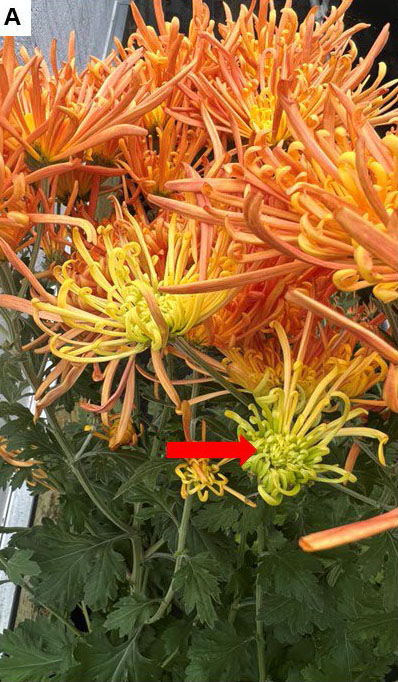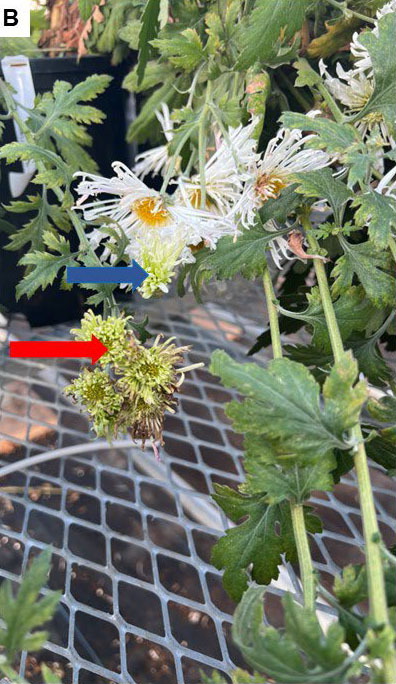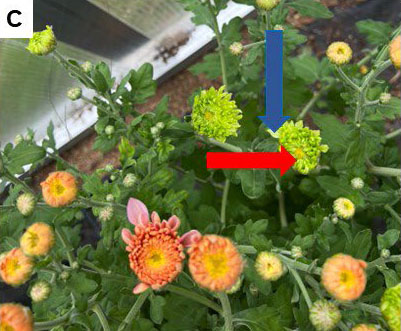Aster Yellows on Chrysanthemums in Oklahoma
Recently (i.e. 2023), aster yellows, caused by the fastidious bacteria, Candidatus Phytoplasma SrI (Aster yellows group), was identified on chrysanthemum (Chrysanthemum morifolium) varieties in Oklahoma. This disease requires improved scouting and vigilance to protect producers and plants from the devastating effects of the disease. Although aster yellows is known to affect multiple plants in Oklahoma, the disease in chrysanthemum is a new and recent occurrence. Infected plants can be asymptomatic or display a range of symptoms including phyllody (anormal development of floral parts into leafy structures), virescence (abnormal development of green pigmentation in plant parts that are not usually green like some shoots and flowers) and witch’s broom (abnormal development of a dense mass of shoot from a single growth point) (Figure 1). Diagnostic assays based on DNA sequencing of the causal agent confirmed the presence of aster yellows on multiple chrysanthemum varieties. Growers and production facilities need to take adequate precautions against aster yellows epidemics. Phytoplasmas can cause devastating economic consequences as there are currently no commercial curative remedies.
Aster Yellows are spread by multiple leafhopper species, including the migratory aster leafhopper, Macrosteles quadrilineatus (Forbes 1885). Leafhoppers are known to start their migration from the southern US when temperatures exceed 59°F, at which time they are likely to be carrying aster yellows pathogens. Leafhoppers feed on infected plant tissues and sap with their piercing and sucking mouthparts, acquiring aster yellows phytoplasmas for subsequent transmission to other plants. While cooler temperatures and rain can stop the movement of leafhoppers, the usually hot and dry summers of Oklahoma provide an ideal environment for movement and feeding. Leafhoppers are phloem-feeders and the acquired aster yellows pathogen is transmitted to other plants through feeding, where it multiplies and colonizes the plants. Infection of plants results in multiple symptoms, including symptomless plants during early infection stages.
| Image | Caption |
|---|---|
 |
Figure A. |
 |
Figure B. |
 |
Figure C. |
 |
Figure D.
|
Figure 1. Plate A-C shows a range of symptoms of phytoplasma diseases on chrysanthemum identified recently in Oklahoma. Symptoms of phytoplasma diseases on chrysanthemums can range from phyllody (floral parts develop into leafy structures, shown in blue arrows), virescence (abnormal development of green pigmentation in plant parts that are not usually green, shown in red arrows), and Witch’s broom (abnormal development of a dense mass of shoot from a single growth point, orange arrow). Symptomless plants (not shown) were also reported. (Photos A-C are grower supplied photo while D was cropped from Taloh et al. 2020)
Figure 2. The major vector of Aster Yellows is the Aster leafhopper, Macrosteles quadrilineatus (Source: https://bugguide.net/node/view/628161).
Aster yellows disease management options for Oklahoma chrysanthemum growers
Although aster yellows does not have curative treatments for infected plants, there are a range of options growers could use to manage the impact of this disease.
| Typical questions | Guide |
|---|---|
| When should I scout for the insect vector? | Due to Oklahoma’s fluctuating weather, scouting for the vector should begin in early spring but expect to find the insects during the summer period. |
| What can I do just before the onset of summer? | Make sure all greenhouse entrances and openings are covered with insect-excluding screening. |
| What are the visible symptoms of aster yellows on chrysanthemums? | Phyllody: abnormal development of floral parts into leafy structures. Virescence: abnormal development of green pigmentation in plant parts that are not usually green like shoots and flowers. Witch’s broom: abnormal development of a dense mass of shoots from a single point. |
| Do I need to test symptomless plants? | Yes, because leafhoppers feed inconspicuously on the phloem and early stages of infection do not show any visible symptoms. Symptoms take months to develop after infection. |
| What is the surest way of knowing my plants are infected with aster yellows? | Using laboratories capable of using molecular DNA detection techniques. Send samples to Plant Disease and Insect Diagnostic Laboratory. |
| What should I do when infection is detected? | Rogue, cull and bury suspect plants. |
| Are there chemical controls against aster yellows and other phytoplasma diseases. | There is no known effective chemical control against phytoplasma diseases. |
| When is insecticidal spray advisable against insects? | Spraying insecticides to manage leafhoppers is not usually recommended since leafhoppers may continue to migrate into areas after an application, creating a potential for insecticide resistance. However, pyrethroids can be applied 2-3 times weekly and timed with leafhopper influxes. |
| Are weeds important sources of inoculum for aster yellows? | Weeds can serve as potential source of inoculum for phytoplasmas, therefore maintain areas clean of weed plant hosts. |
| What other plants can serve as host for aster yellows? | Multiple plants, including canola, wheat, celery, onions, tomatoes, peppers, etc. See more at Oklahoma Gardening, Aster Yellows. |
References
Crop Protection Network (2019). Aster Yellows of Wheat. https://cropprotectionnetwork.org/encyclopedia/aster-yellows-of-wheat.
Damicone, J. (2017). Canola Disease Update. Pest e-alerts Vol. 16, No. 26. https://extension.okstate.edu/e-pest-alerts/site-files/documents/2017/canola-disease-update-june-2-2017.pdf.
Rebek, E.J. (2008). Be on the lookout for Aster Yellows. Plant Disease and Insect Advisory, Vol. 7, No. 15. https://extension.okstate.edu/e-pest-alerts/site-files/documents/2008/be-on-the-lookout-for-aster-yellows-may-15-2008.pdf.
Taloh, A., Raju, D. V. S., Banyal, N., Kumar, G., Panda, P., Manimekalai, R., Marcone, C., & Rao, G. P. (2020). Genetic diversity of phytoplasma strains infecting chrysanthemum varieties in India and their possible natural reservoirs. 3 Biotech, 10(9), 411. https://doi.org/10.1007/s13205-020-02407-x

